Meta-analysis: Strict Glucose Control and Diabetic Neuropathy
VerifiedAdded on 2023/03/17
|9
|1616
|87
Report
AI Summary
This meta-analysis examines the impact of strict glucose control on diabetic neuropathy by reviewing multiple studies. The research includes data extraction using search terms such as 'Glucose Control' and 'Diabetic Neuropathy', with databases like Google Scholar and PubMed. The study uses inclusion criteria such as randomized control trials and focuses on Type 1 and Type 2 diabetes. Exclusion criteria included non-experimental studies. The report includes a PRISMA flow diagram, bias assessment, and a table summarizing the included studies. The analysis uses RevMan software to compare experimental and control groups, presenting results on mean differences, standard deviations, and p-values. The findings indicate that strict glucose control can minimize Distal Sensory Polyneuropathy symptoms for both diabetes types. The report concludes with references to relevant literature. The report provides valuable insight into the effect of strict glucose control on diabetic neuropathy.

Running head: META-ANALYSIS
Meta-analysis
Name of the Student
Name of the University
Author note
Meta-analysis
Name of the Student
Name of the University
Author note
Paraphrase This Document
Need a fresh take? Get an instant paraphrase of this document with our AI Paraphraser
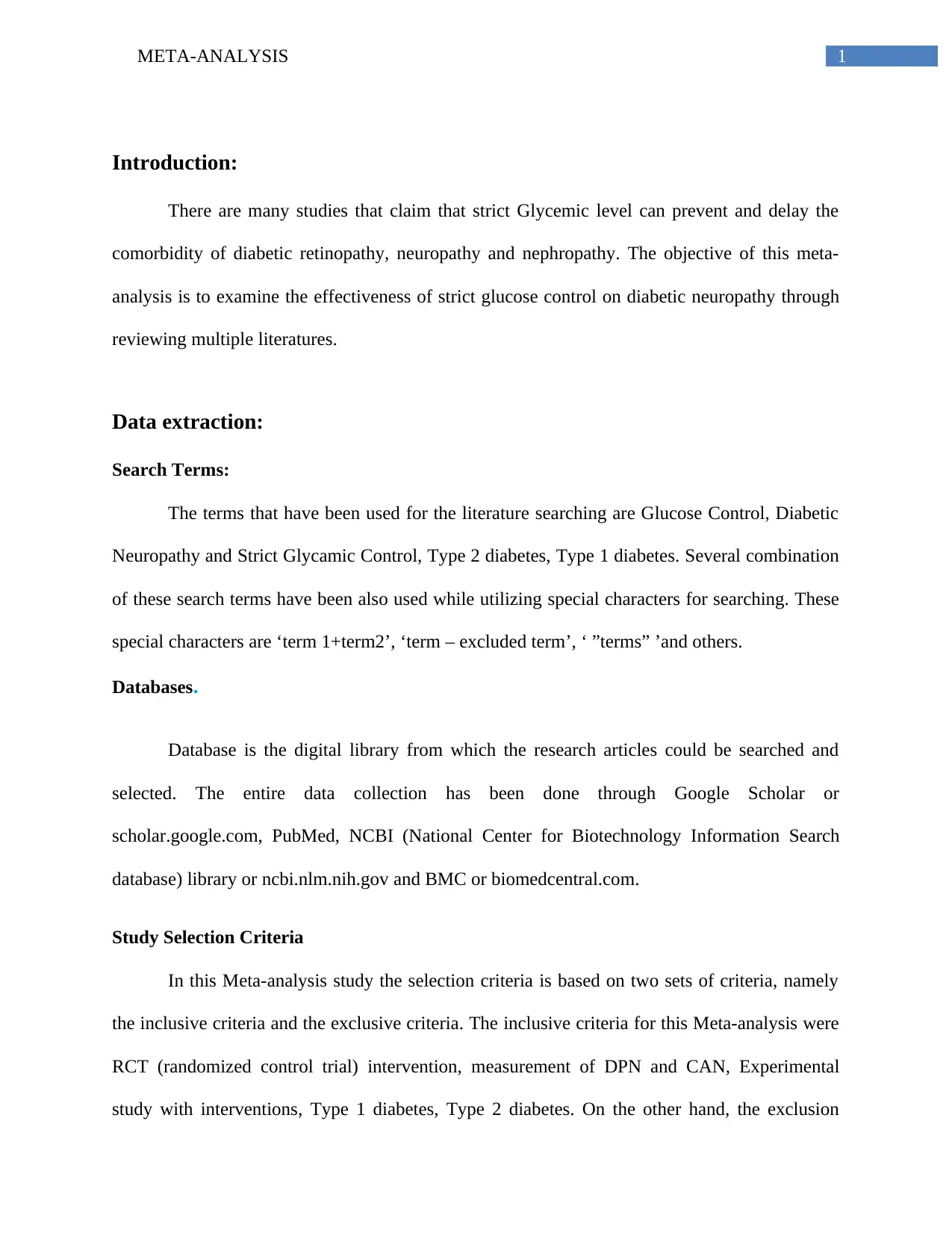
1META-ANALYSIS
Introduction:
There are many studies that claim that strict Glycemic level can prevent and delay the
comorbidity of diabetic retinopathy, neuropathy and nephropathy. The objective of this meta-
analysis is to examine the effectiveness of strict glucose control on diabetic neuropathy through
reviewing multiple literatures.
Data extraction:
Search Terms:
The terms that have been used for the literature searching are Glucose Control, Diabetic
Neuropathy and Strict Glycamic Control, Type 2 diabetes, Type 1 diabetes. Several combination
of these search terms have been also used while utilizing special characters for searching. These
special characters are ‘term 1+term2’, ‘term – excluded term’, ‘ ”terms” ’and others.
Databases.
Database is the digital library from which the research articles could be searched and
selected. The entire data collection has been done through Google Scholar or
scholar.google.com, PubMed, NCBI (National Center for Biotechnology Information Search
database) library or ncbi.nlm.nih.gov and BMC or biomedcentral.com.
Study Selection Criteria
In this Meta-analysis study the selection criteria is based on two sets of criteria, namely
the inclusive criteria and the exclusive criteria. The inclusive criteria for this Meta-analysis were
RCT (randomized control trial) intervention, measurement of DPN and CAN, Experimental
study with interventions, Type 1 diabetes, Type 2 diabetes. On the other hand, the exclusion
Introduction:
There are many studies that claim that strict Glycemic level can prevent and delay the
comorbidity of diabetic retinopathy, neuropathy and nephropathy. The objective of this meta-
analysis is to examine the effectiveness of strict glucose control on diabetic neuropathy through
reviewing multiple literatures.
Data extraction:
Search Terms:
The terms that have been used for the literature searching are Glucose Control, Diabetic
Neuropathy and Strict Glycamic Control, Type 2 diabetes, Type 1 diabetes. Several combination
of these search terms have been also used while utilizing special characters for searching. These
special characters are ‘term 1+term2’, ‘term – excluded term’, ‘ ”terms” ’and others.
Databases.
Database is the digital library from which the research articles could be searched and
selected. The entire data collection has been done through Google Scholar or
scholar.google.com, PubMed, NCBI (National Center for Biotechnology Information Search
database) library or ncbi.nlm.nih.gov and BMC or biomedcentral.com.
Study Selection Criteria
In this Meta-analysis study the selection criteria is based on two sets of criteria, namely
the inclusive criteria and the exclusive criteria. The inclusive criteria for this Meta-analysis were
RCT (randomized control trial) intervention, measurement of DPN and CAN, Experimental
study with interventions, Type 1 diabetes, Type 2 diabetes. On the other hand, the exclusion
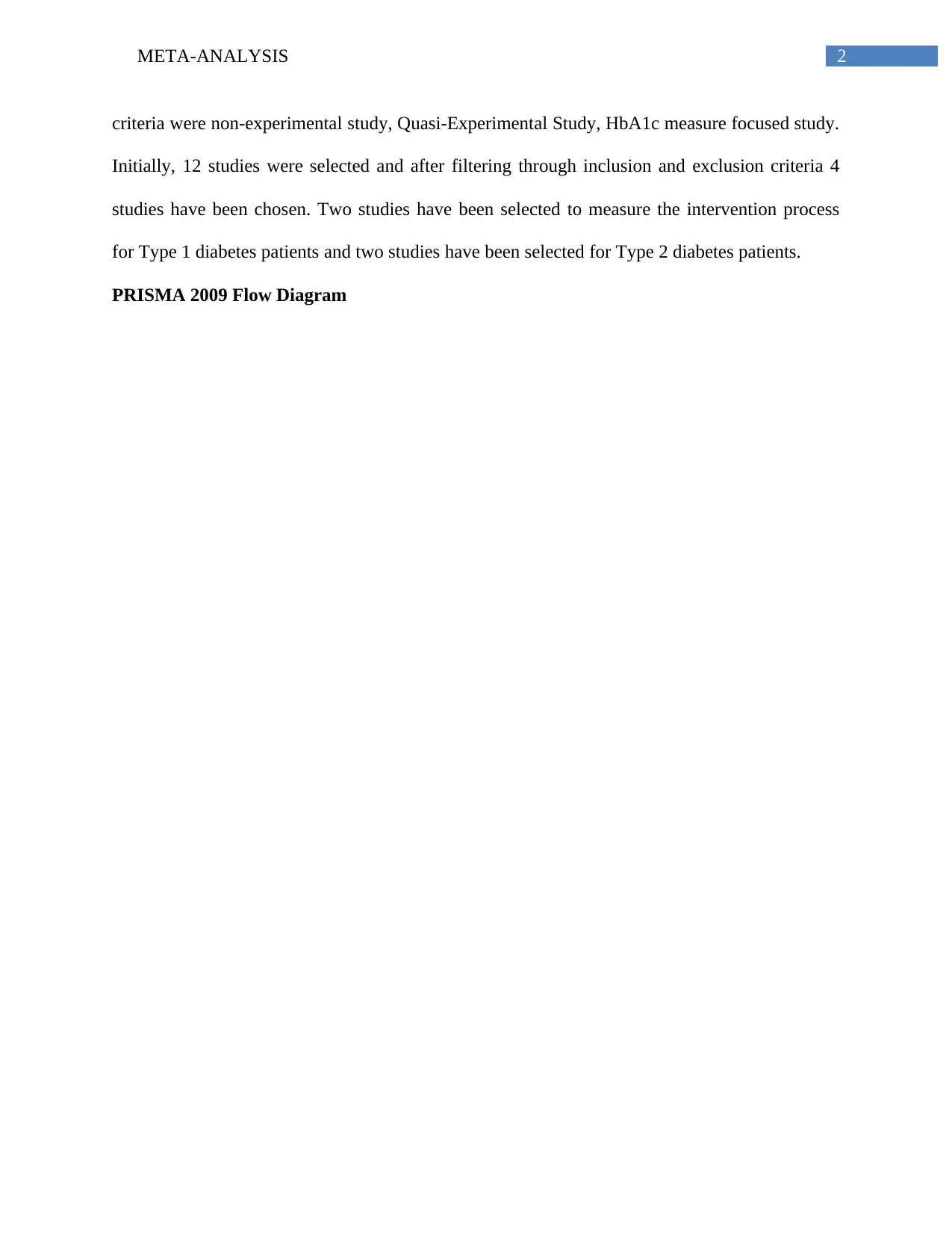
2META-ANALYSIS
criteria were non-experimental study, Quasi-Experimental Study, HbA1c measure focused study.
Initially, 12 studies were selected and after filtering through inclusion and exclusion criteria 4
studies have been chosen. Two studies have been selected to measure the intervention process
for Type 1 diabetes patients and two studies have been selected for Type 2 diabetes patients.
PRISMA 2009 Flow Diagram
criteria were non-experimental study, Quasi-Experimental Study, HbA1c measure focused study.
Initially, 12 studies were selected and after filtering through inclusion and exclusion criteria 4
studies have been chosen. Two studies have been selected to measure the intervention process
for Type 1 diabetes patients and two studies have been selected for Type 2 diabetes patients.
PRISMA 2009 Flow Diagram
⊘ This is a preview!⊘
Do you want full access?
Subscribe today to unlock all pages.

Trusted by 1+ million students worldwide
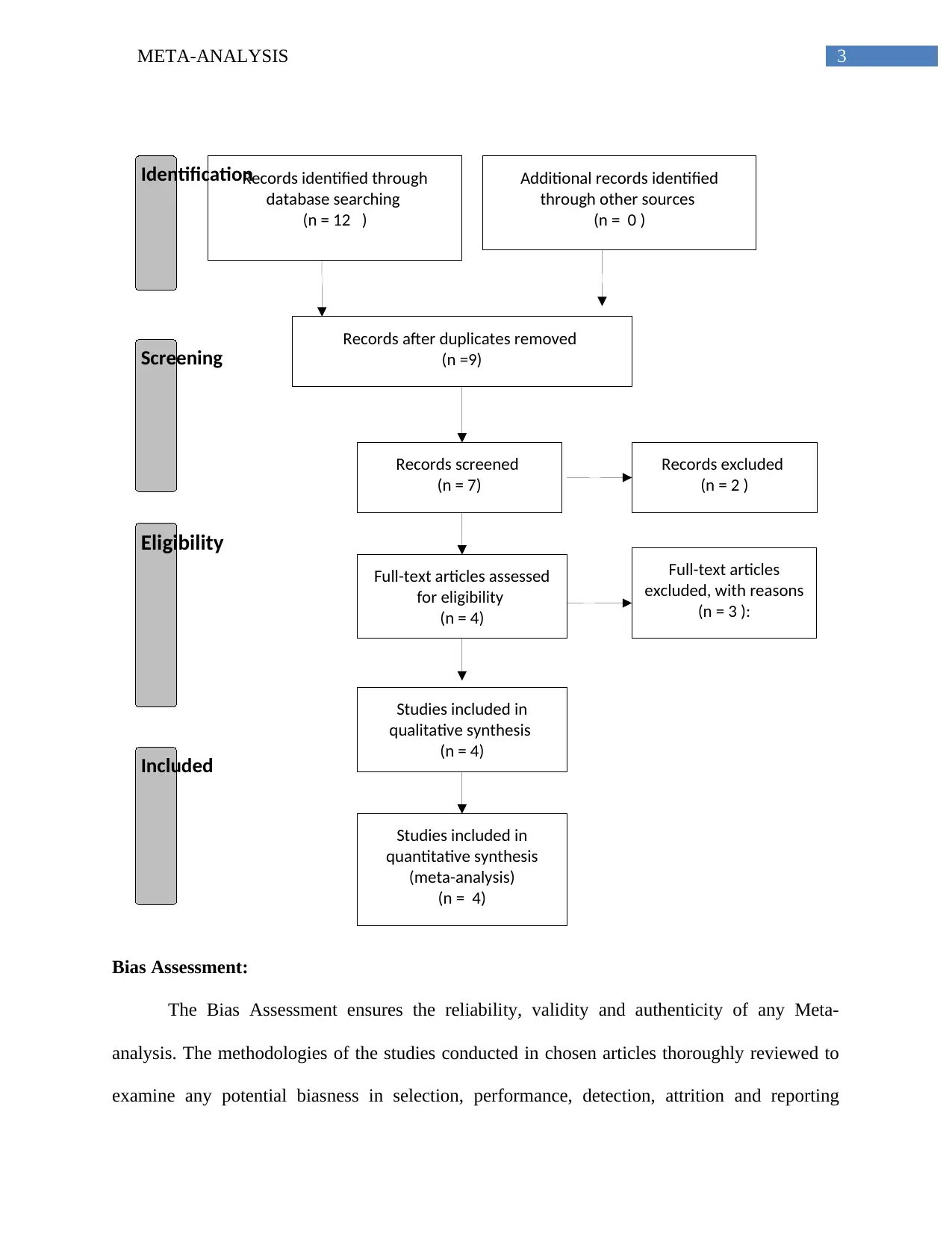
3META-ANALYSIS
Records identified through
database searching
(n = 12 )
Screening
Included
Eligibility
Identification Additional records identified
through other sources
(n = 0 )
Records after duplicates removed
(n =9)
Records screened
(n = 7)
Records excluded
(n = 2 )
Full-text articles assessed
for eligibility
(n = 4)
Full-text articles
excluded, with reasons
(n = 3 ):
Studies included in
qualitative synthesis
(n = 4)
Studies included in
quantitative synthesis
(meta-analysis)
(n = 4)
Bias Assessment:
The Bias Assessment ensures the reliability, validity and authenticity of any Meta-
analysis. The methodologies of the studies conducted in chosen articles thoroughly reviewed to
examine any potential biasness in selection, performance, detection, attrition and reporting
Records identified through
database searching
(n = 12 )
Screening
Included
Eligibility
Identification Additional records identified
through other sources
(n = 0 )
Records after duplicates removed
(n =9)
Records screened
(n = 7)
Records excluded
(n = 2 )
Full-text articles assessed
for eligibility
(n = 4)
Full-text articles
excluded, with reasons
(n = 3 ):
Studies included in
qualitative synthesis
(n = 4)
Studies included in
quantitative synthesis
(meta-analysis)
(n = 4)
Bias Assessment:
The Bias Assessment ensures the reliability, validity and authenticity of any Meta-
analysis. The methodologies of the studies conducted in chosen articles thoroughly reviewed to
examine any potential biasness in selection, performance, detection, attrition and reporting
Paraphrase This Document
Need a fresh take? Get an instant paraphrase of this document with our AI Paraphraser

4META-ANALYSIS
section. Each intervention methods and sampling methods used by chosen studies assessed by
their allocation style and to reporting style. For this same reason, this analysis has only
considered the randomized controlled trial instead of quasi experimental tests in order to avoid
biasness in performance.
section. Each intervention methods and sampling methods used by chosen studies assessed by
their allocation style and to reporting style. For this same reason, this analysis has only
considered the randomized controlled trial instead of quasi experimental tests in order to avoid
biasness in performance.

5META-ANALYSIS
Studies included in quantitative synthesis
Authors Years Journal Study
DiabetesControl and
Complications Trial
Research Group
1998 Diabetologia The effect of intensive diabetes therapy on
measures of autonomic nervous system
function in the Diabetes Control and
Complications Trial (DCCT)
Amthor, K.F., Dahl-
Jørgensen, K., Berg, T.J.,
Heier, M.S., Sandvik, L.,
Aagenæs, Ø. and
Hanssen, K.F.,
1994 Diabetologia The effect of 8 years of strict glycaemic
control on peripheral nerve function in
IDDM patients: the Oslo Study.
Ohkubo, Y., Kishikawa,
H., Araki, E., Miyata, T.,
Isami, S., Motoyoshi, S.,
Kojima, Y., Furuyoshi, N.
and Shichiri, M.,
1995 Diabetes
research and
clinical practice
Intensive insulin therapy prevents the
progression of diabetic microvascular
complications in Japanese patients with
non-insulin-dependent diabetes mellitus: a
randomized prospective 6-year study.
Ismail-Beigi, F., Craven,
T., Banerji, M.A., Basile,
J., Calles, J., Cohen,
R.M., Cuddihy, R.,
Cushman, W.C., Genuth,
S., Grimm Jr, R.H. and
Hamilton, B.P.,
2010 The Lancet Effect of intensive treatment of
hyperglycaemia on microvascular outcomes
in type 2 diabetes: an analysis of the
ACCORD randomised trial.
Methods of analysis
In this study a Meta-analysis software named RevMan has been used for data analysis.
For Meta-analysis the experimental population and control population has been considered.
Apart from that the mean difference of Diabetic Neuropathy occurrence before and after the
intervention has been calculated for both experimental as well as control group. Additionally, the
numerical results in standard deviations and probability testing value or p-value have been
considered.
Analytical presentation for Meta-analysis
Studies included in quantitative synthesis
Authors Years Journal Study
DiabetesControl and
Complications Trial
Research Group
1998 Diabetologia The effect of intensive diabetes therapy on
measures of autonomic nervous system
function in the Diabetes Control and
Complications Trial (DCCT)
Amthor, K.F., Dahl-
Jørgensen, K., Berg, T.J.,
Heier, M.S., Sandvik, L.,
Aagenæs, Ø. and
Hanssen, K.F.,
1994 Diabetologia The effect of 8 years of strict glycaemic
control on peripheral nerve function in
IDDM patients: the Oslo Study.
Ohkubo, Y., Kishikawa,
H., Araki, E., Miyata, T.,
Isami, S., Motoyoshi, S.,
Kojima, Y., Furuyoshi, N.
and Shichiri, M.,
1995 Diabetes
research and
clinical practice
Intensive insulin therapy prevents the
progression of diabetic microvascular
complications in Japanese patients with
non-insulin-dependent diabetes mellitus: a
randomized prospective 6-year study.
Ismail-Beigi, F., Craven,
T., Banerji, M.A., Basile,
J., Calles, J., Cohen,
R.M., Cuddihy, R.,
Cushman, W.C., Genuth,
S., Grimm Jr, R.H. and
Hamilton, B.P.,
2010 The Lancet Effect of intensive treatment of
hyperglycaemia on microvascular outcomes
in type 2 diabetes: an analysis of the
ACCORD randomised trial.
Methods of analysis
In this study a Meta-analysis software named RevMan has been used for data analysis.
For Meta-analysis the experimental population and control population has been considered.
Apart from that the mean difference of Diabetic Neuropathy occurrence before and after the
intervention has been calculated for both experimental as well as control group. Additionally, the
numerical results in standard deviations and probability testing value or p-value have been
considered.
Analytical presentation for Meta-analysis
⊘ This is a preview!⊘
Do you want full access?
Subscribe today to unlock all pages.

Trusted by 1+ million students worldwide
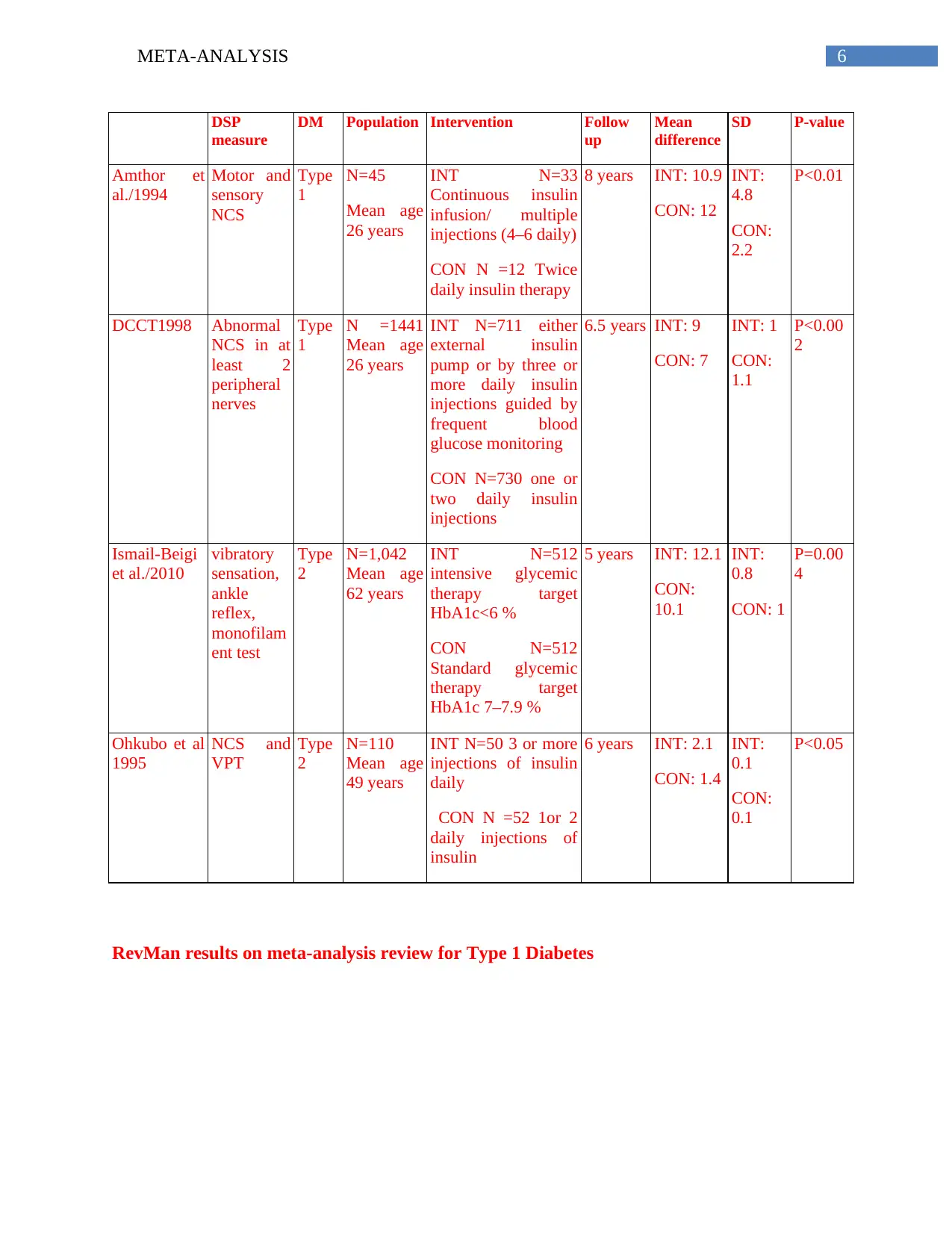
6META-ANALYSIS
DSP
measure
DM Population Intervention Follow
up
Mean
difference
SD P-value
Amthor et
al./1994
Motor and
sensory
NCS
Type
1
N=45
Mean age
26 years
INT N=33
Continuous insulin
infusion/ multiple
injections (4–6 daily)
CON N =12 Twice
daily insulin therapy
8 years INT: 10.9
CON: 12
INT:
4.8
CON:
2.2
P<0.01
DCCT1998 Abnormal
NCS in at
least 2
peripheral
nerves
Type
1
N =1441
Mean age
26 years
INT N=711 either
external insulin
pump or by three or
more daily insulin
injections guided by
frequent blood
glucose monitoring
CON N=730 one or
two daily insulin
injections
6.5 years INT: 9
CON: 7
INT: 1
CON:
1.1
P<0.00
2
Ismail-Beigi
et al./2010
vibratory
sensation,
ankle
reflex,
monofilam
ent test
Type
2
N=1,042
Mean age
62 years
INT N=512
intensive glycemic
therapy target
HbA1c<6 %
CON N=512
Standard glycemic
therapy target
HbA1c 7–7.9 %
5 years INT: 12.1
CON:
10.1
INT:
0.8
CON: 1
P=0.00
4
Ohkubo et al
1995
NCS and
VPT
Type
2
N=110
Mean age
49 years
INT N=50 3 or more
injections of insulin
daily
CON N =52 1or 2
daily injections of
insulin
6 years INT: 2.1
CON: 1.4
INT:
0.1
CON:
0.1
P<0.05
RevMan results on meta-analysis review for Type 1 Diabetes
DSP
measure
DM Population Intervention Follow
up
Mean
difference
SD P-value
Amthor et
al./1994
Motor and
sensory
NCS
Type
1
N=45
Mean age
26 years
INT N=33
Continuous insulin
infusion/ multiple
injections (4–6 daily)
CON N =12 Twice
daily insulin therapy
8 years INT: 10.9
CON: 12
INT:
4.8
CON:
2.2
P<0.01
DCCT1998 Abnormal
NCS in at
least 2
peripheral
nerves
Type
1
N =1441
Mean age
26 years
INT N=711 either
external insulin
pump or by three or
more daily insulin
injections guided by
frequent blood
glucose monitoring
CON N=730 one or
two daily insulin
injections
6.5 years INT: 9
CON: 7
INT: 1
CON:
1.1
P<0.00
2
Ismail-Beigi
et al./2010
vibratory
sensation,
ankle
reflex,
monofilam
ent test
Type
2
N=1,042
Mean age
62 years
INT N=512
intensive glycemic
therapy target
HbA1c<6 %
CON N=512
Standard glycemic
therapy target
HbA1c 7–7.9 %
5 years INT: 12.1
CON:
10.1
INT:
0.8
CON: 1
P=0.00
4
Ohkubo et al
1995
NCS and
VPT
Type
2
N=110
Mean age
49 years
INT N=50 3 or more
injections of insulin
daily
CON N =52 1or 2
daily injections of
insulin
6 years INT: 2.1
CON: 1.4
INT:
0.1
CON:
0.1
P<0.05
RevMan results on meta-analysis review for Type 1 Diabetes
Paraphrase This Document
Need a fresh take? Get an instant paraphrase of this document with our AI Paraphraser
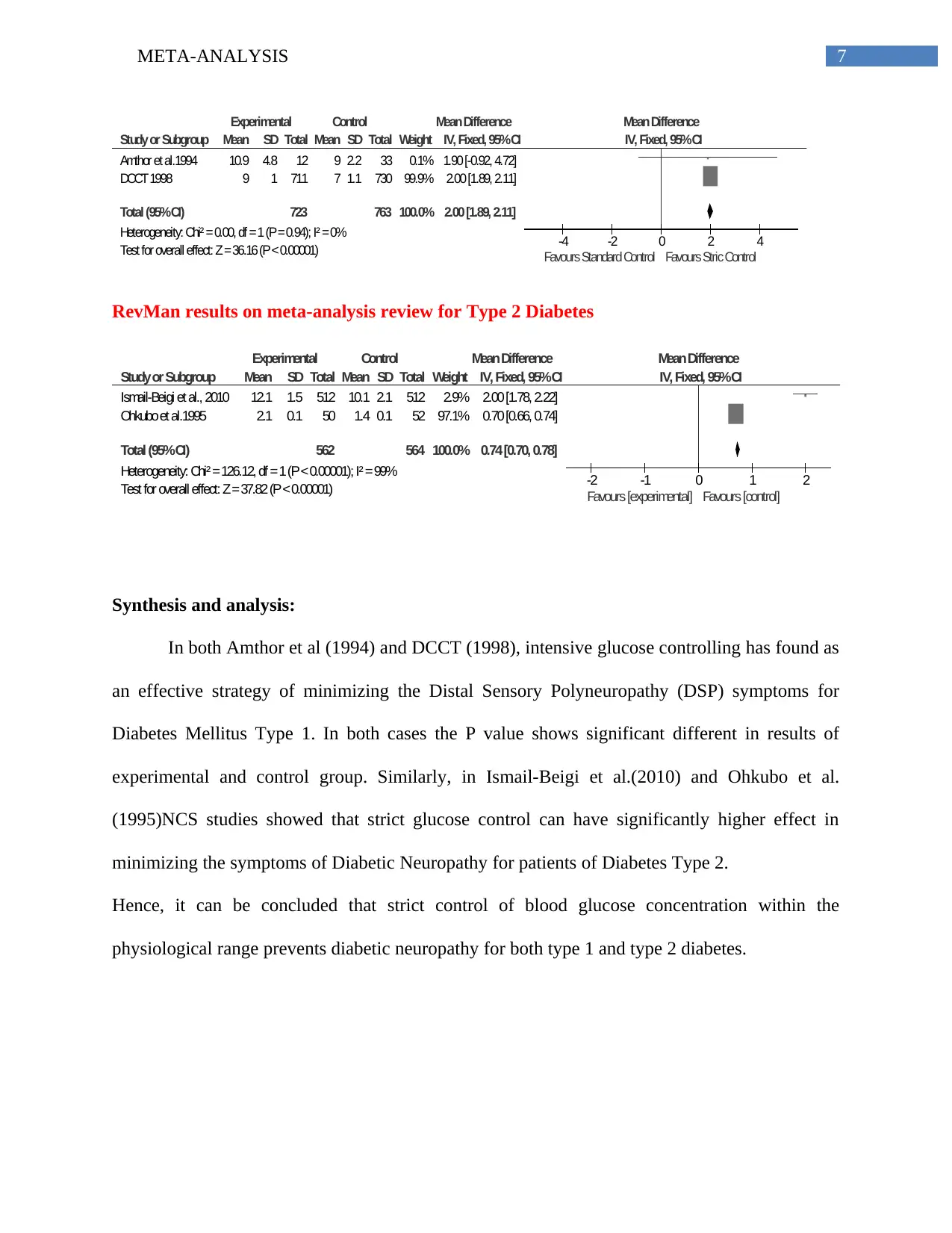
7META-ANALYSIS
Study or Subgroup
Amthor et al.1994
DCCT 1998
Total (95%CI)
Heterogeneity: Chi² = 0.00, df = 1 (P= 0.94); I² = 0%
Test for overall effect: Z = 36.16 (P < 0.00001)
Mean
10.9
9
SD
4.8
1
Total
12
711
723
Mean
9
7
SD
2.2
1.1
Total
33
730
763
Weight
0.1%
99.9%
100.0%
IV, Fixed, 95%CI
1.90 [-0.92, 4.72]
2.00 [1.89, 2.11]
2.00 [1.89, 2.11]
Experimental Control Mean Difference Mean Difference
IV, Fixed, 95%CI
-4 -2 0 2 4
Favours Standard Control Favours Stric Control
RevMan results on meta-analysis review for Type 2 Diabetes
Study or Subgroup
Ismail-Beigi et al., 2010
Ohkubo et al.1995
Total (95%CI)
Heterogeneity: Chi² = 126.12, df = 1 (P < 0.00001); I² = 99%
Test for overall effect: Z = 37.82 (P < 0.00001)
Mean
12.1
2.1
SD
1.5
0.1
Total
512
50
562
Mean
10.1
1.4
SD
2.1
0.1
Total
512
52
564
Weight
2.9%
97.1%
100.0%
IV, Fixed, 95%CI
2.00 [1.78, 2.22]
0.70 [0.66, 0.74]
0.74 [0.70, 0.78]
Experimental Control Mean Difference Mean Difference
IV, Fixed, 95%CI
-2 -1 0 1 2
Favours [experimental] Favours [control]
Synthesis and analysis:
In both Amthor et al (1994) and DCCT (1998), intensive glucose controlling has found as
an effective strategy of minimizing the Distal Sensory Polyneuropathy (DSP) symptoms for
Diabetes Mellitus Type 1. In both cases the P value shows significant different in results of
experimental and control group. Similarly, in Ismail-Beigi et al.(2010) and Ohkubo et al.
(1995)NCS studies showed that strict glucose control can have significantly higher effect in
minimizing the symptoms of Diabetic Neuropathy for patients of Diabetes Type 2.
Hence, it can be concluded that strict control of blood glucose concentration within the
physiological range prevents diabetic neuropathy for both type 1 and type 2 diabetes.
Study or Subgroup
Amthor et al.1994
DCCT 1998
Total (95%CI)
Heterogeneity: Chi² = 0.00, df = 1 (P= 0.94); I² = 0%
Test for overall effect: Z = 36.16 (P < 0.00001)
Mean
10.9
9
SD
4.8
1
Total
12
711
723
Mean
9
7
SD
2.2
1.1
Total
33
730
763
Weight
0.1%
99.9%
100.0%
IV, Fixed, 95%CI
1.90 [-0.92, 4.72]
2.00 [1.89, 2.11]
2.00 [1.89, 2.11]
Experimental Control Mean Difference Mean Difference
IV, Fixed, 95%CI
-4 -2 0 2 4
Favours Standard Control Favours Stric Control
RevMan results on meta-analysis review for Type 2 Diabetes
Study or Subgroup
Ismail-Beigi et al., 2010
Ohkubo et al.1995
Total (95%CI)
Heterogeneity: Chi² = 126.12, df = 1 (P < 0.00001); I² = 99%
Test for overall effect: Z = 37.82 (P < 0.00001)
Mean
12.1
2.1
SD
1.5
0.1
Total
512
50
562
Mean
10.1
1.4
SD
2.1
0.1
Total
512
52
564
Weight
2.9%
97.1%
100.0%
IV, Fixed, 95%CI
2.00 [1.78, 2.22]
0.70 [0.66, 0.74]
0.74 [0.70, 0.78]
Experimental Control Mean Difference Mean Difference
IV, Fixed, 95%CI
-2 -1 0 1 2
Favours [experimental] Favours [control]
Synthesis and analysis:
In both Amthor et al (1994) and DCCT (1998), intensive glucose controlling has found as
an effective strategy of minimizing the Distal Sensory Polyneuropathy (DSP) symptoms for
Diabetes Mellitus Type 1. In both cases the P value shows significant different in results of
experimental and control group. Similarly, in Ismail-Beigi et al.(2010) and Ohkubo et al.
(1995)NCS studies showed that strict glucose control can have significantly higher effect in
minimizing the symptoms of Diabetic Neuropathy for patients of Diabetes Type 2.
Hence, it can be concluded that strict control of blood glucose concentration within the
physiological range prevents diabetic neuropathy for both type 1 and type 2 diabetes.
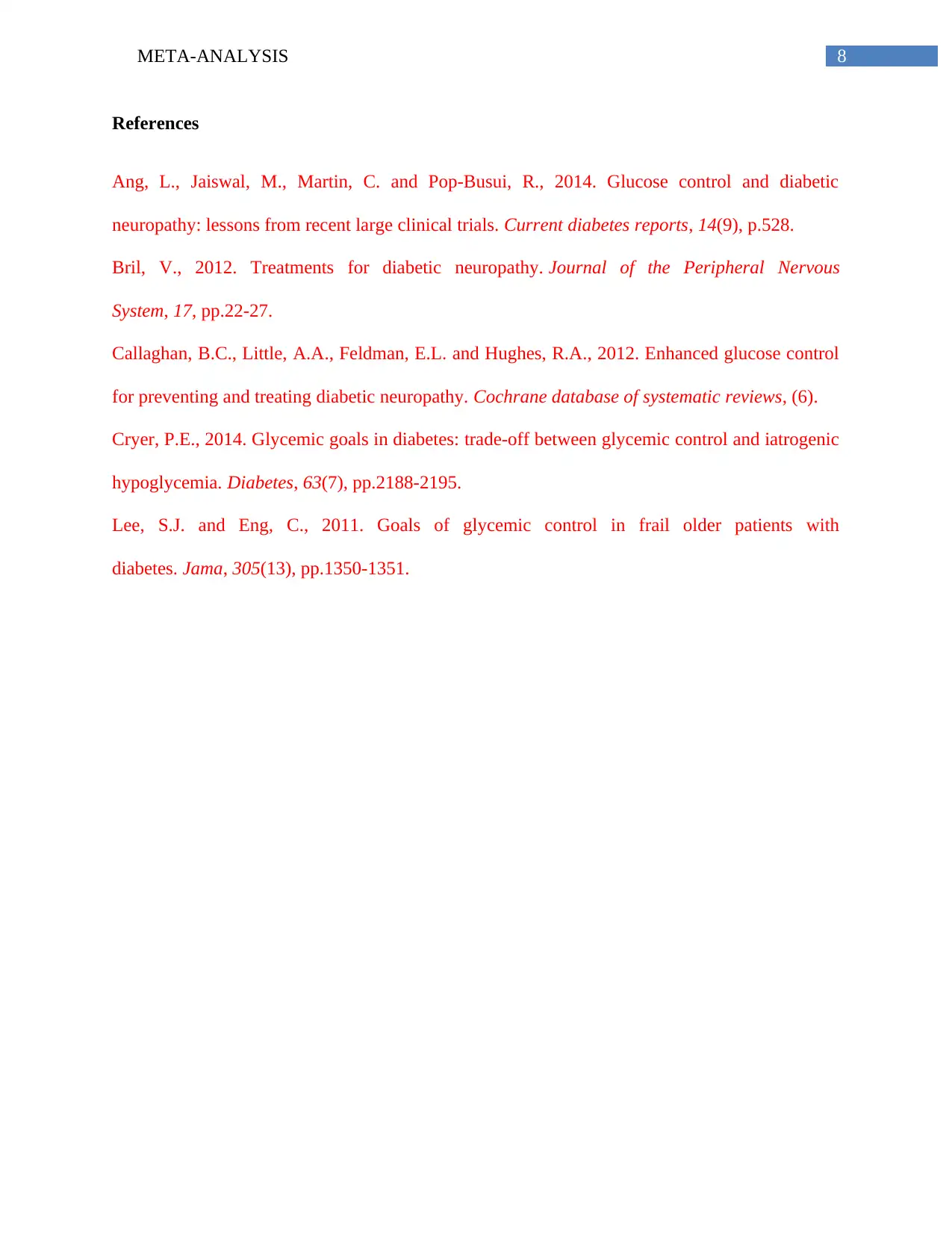
8META-ANALYSIS
References
Ang, L., Jaiswal, M., Martin, C. and Pop-Busui, R., 2014. Glucose control and diabetic
neuropathy: lessons from recent large clinical trials. Current diabetes reports, 14(9), p.528.
Bril, V., 2012. Treatments for diabetic neuropathy. Journal of the Peripheral Nervous
System, 17, pp.22-27.
Callaghan, B.C., Little, A.A., Feldman, E.L. and Hughes, R.A., 2012. Enhanced glucose control
for preventing and treating diabetic neuropathy. Cochrane database of systematic reviews, (6).
Cryer, P.E., 2014. Glycemic goals in diabetes: trade-off between glycemic control and iatrogenic
hypoglycemia. Diabetes, 63(7), pp.2188-2195.
Lee, S.J. and Eng, C., 2011. Goals of glycemic control in frail older patients with
diabetes. Jama, 305(13), pp.1350-1351.
References
Ang, L., Jaiswal, M., Martin, C. and Pop-Busui, R., 2014. Glucose control and diabetic
neuropathy: lessons from recent large clinical trials. Current diabetes reports, 14(9), p.528.
Bril, V., 2012. Treatments for diabetic neuropathy. Journal of the Peripheral Nervous
System, 17, pp.22-27.
Callaghan, B.C., Little, A.A., Feldman, E.L. and Hughes, R.A., 2012. Enhanced glucose control
for preventing and treating diabetic neuropathy. Cochrane database of systematic reviews, (6).
Cryer, P.E., 2014. Glycemic goals in diabetes: trade-off between glycemic control and iatrogenic
hypoglycemia. Diabetes, 63(7), pp.2188-2195.
Lee, S.J. and Eng, C., 2011. Goals of glycemic control in frail older patients with
diabetes. Jama, 305(13), pp.1350-1351.
⊘ This is a preview!⊘
Do you want full access?
Subscribe today to unlock all pages.

Trusted by 1+ million students worldwide
1 out of 9
Related Documents
Your All-in-One AI-Powered Toolkit for Academic Success.
+13062052269
info@desklib.com
Available 24*7 on WhatsApp / Email
![[object Object]](/_next/static/media/star-bottom.7253800d.svg)
Unlock your academic potential
Copyright © 2020–2025 A2Z Services. All Rights Reserved. Developed and managed by ZUCOL.





